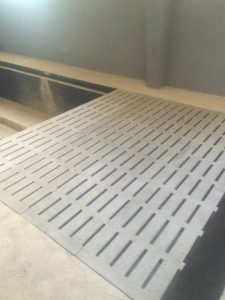How to choose slat floor for pig farm
The choice and composition of the slatted floor is an important point in production.
The main way of animals keeping in modern production is carried out on slatted floors (semi-slatted). This is due to the use of a self-removing manure system. This allows you to keep animals clean and reduce the labor costs of employees for cleaning stables.
There are legislative norms, as well as recommendations of which floors should be used and where, what ratio should be between slotted and solid floor.

In the insemination and gestation section, as usually , we use concrete slatted floors in combination with a solid floor. In the insemination section, when sows are kept in single pens, there is a slatted floor from the back of the sows and a solid one in the front. Sows will be more comfortable lying on a solid floor, because there is no draught, and also – this will reduce feed loss during feeding or pouring feed through the trough. At the same time, to maintain cleanliness and ease of cleaning in the rear, a slatted floor is advisable.
If we are talking about group holding of sows in gestation: since in such a situation it is a little difficult to clearly predict where the sow will lie and where not, either a completely slatted floor option or a combination with 1/3 solid floor is used.
When choosing concrete slatted floors, it is important to pay attention to the quality of the gratings, namely that they do not crumble, are resistant to intensive use, and straight; the surface should not be perfectly smooth, but moderately rough, so that the animals do not slip on them, but at the same time, without bulges, to not injure the delicate pads near the hooves. It is also very important that when sow is laying the floor straight and tight so that the gratings do not move.
All this is very important, since all these moments, in the future, will be reflected in the health of the legs of our animals – joints, hooves and the service life of the gratings.
The size of concrete gratings can be different: a length of up to 2.5 meters allows you to choose the most optimal size for the manure removal channel you have designed.

For farrowing and weaning, plastic and cast-iron grates are used there. There is a wide variety of gratings – full slatted, half slatted, with anti-slip edging, without edging, cast iron, with concrete inserts, with 10% slats, and heating panels. Thanks to this, we can combine the space for animals as precisely as possible according to their needs, as well as save money in those places where you should not overpay.
Very important: when choosing slats, we must take into account the rigidity, comfort and heat transfer of the material. For example, it will be uncomfortable for a sow to stand on plastic, as it is a soft material and under the heavy weight of the sow, the floor will sag. This can lead to additional stress on the joints / cartilage near the hooves and, subsequently, turn into inflammatory processes. It is for this reason that it is not recommended to install plastic floors in fattening as well. On the other hand, cast iron slats will not be as comfortable for little piglets, it is a stiffer and colder material than plastic, so they are unlikely to choose it for laying. Plastic slat for a sow, which can withstand 250-300 kg, will cost more than a plastic slat with a load of up to 50 kg, which allows us to save on equipment cost. We combine floor heating for the piglets in order to reach the optimal temperature, because this is a critical survival factor, especially in the early days.
Not only the right choice of floors and the right technological layout have a big impact on production performance,the quality of the floors is equally important.
So, for example, many are faced with such a problem as a “hurt nipple” in a sow. This happens at farrowing section, when, sow lying down, the teats pass through the opening in the slats, fill with milk and, when getting up, sow damages them. This is the difference between grating manufacturers, the complexity of production, as well as their knowledge and competencies to take into account such moments. If suddenly such a problem already exists, the first thing to do is simply to feel the edges of the opening and modify them so that they become smoother, thereby reducing the risk of the nipples damage.
Реализованные проекты
Группа Компаний «ДАХМИРА» - современное оборудование для свинокомплексов, птицефабрик, рыбхозов, КРС и МРС.
Смотреть все
